Optimizing the Composition of Silicone Enamel to Ensure Maximum Aggregative Stability of Its Suspensions Using Surfactant Obtained from Oil Refining Waste
Abstract
:1. Introduction
2. Materials and Methods
2.1. Materials
2.2. Measurement of Aggregative Stability of Suspensions “Aluminum Pigment-PPhS-Toluene”
2.3. Experimental Design
- The content of surfactant AS-1 (hereinafter CS)—from 0 to 0.75 g/dm3;
- The solvent content (hereinafter referred to as SC)—from 10 to 30% (by weight of the composition).
Planning an Experiment Using the Taguchi Method
2.4. Methodology for Checking the Quality of Coatings
2.5. Adsorption Measurements
3. Results
3.1. Effects of Surfactants on the Aggregative Stability of Suspensions “Aluminum Pigment-PPhS-Toluene”
3.2. Optimization of Aggregative Stability of Suspensions by Taguchi Method
3.3. Investigation of Surfactant Adsorption on Pigment
3.4. The Effects of Surfactants on the Quality of Coatings
4. Discussion
5. Conclusions
Author Contributions
Funding
Institutional Review Board Statement
Data Availability Statement
Acknowledgments
Conflicts of Interest
References
- Witucki, G.L. The Evolution of Silicon-Based Technology in Coatings. Dow Corning Corp. 2003, 8. Available online: https://www.dow.com/content/dam/dcc/documents/en-us/tech-art/26/26-12/26-1208-01-evolution-of-silicone-based-technology.pdf?iframe=true (accessed on 22 August 2022).
- Lu, Y.; Chen, Z.; Wang, C.; Zhao, Q.; Zhang, K.; Du, Y.; Xin, L.; Zhu, S.; Wang, F. Protection of 304 stainless steel by nano-modified silicone coating in cyclically alternate corrosion environment. Corros. Sci. 2021, 190, 109712. [Google Scholar] [CrossRef]
- Fattahi, A.M.; Safaei, B.; Qin, Z.; Chu, F. Experimental studies on elastic properties of high density polyethylene-multi walled carbon nanotube nanocomposites. Steel Compos. Struct. 2021, 38, 177–187. [Google Scholar] [CrossRef]
- Tebeta, R.T.; Fattahi, A.M.; Ahmed, N.A. Experimental and numerical study on HDPE/SWCNT nanocomposite elastic properties considering the processing techniques effect. Microsyst. Technol. 2020, 26, 2423–2441. [Google Scholar] [CrossRef]
- Li, X.; Yoneda, M.; Shimada, Y.; Matsui, Y. Effect of surfactants on the aggregation and sedimentation of zinc oxide nanomaterial in natural water matrices. Sci. Total Environ. 2017, 581–582, 649–656. [Google Scholar] [CrossRef]
- Chen, H.-N.; Huang, C.-T.; Tseng, W.J.; Wei, M.-H. Dispersion and rheology of surfactant-mediated silver nanoparticle suspensions. Appl. Surf. Sci. 2010, 257, 650–655. [Google Scholar] [CrossRef]
- Colic, M.; Fuerstenau, D.W. The influence of surfactant impurities on colloid stability and dispersion of powders in aqueous suspensions. Powder Technol. 1998, 97, 129–138. [Google Scholar] [CrossRef]
- Jin, L.; Haiyan, Z.; Ping, L.; Xijiang, Y.; Aikseng, L. The accelerated de-dispersion and sedimentation behaviors of multi walled carbon nanotube suspensions using surfactants. Mater. Chem. Phys. 2013, 142, 667–676. [Google Scholar] [CrossRef]
- Tkachenko, N.H.; Yaremko, Z.M.; Bellmann, C.; Soltys, M.M. The influence of ionic and nonionic surfactants on aggregative stability and electrical surface properties of aqueous suspensions of titanium dioxide. J. Colloid Interface Sci. 2006, 299, 686–695. [Google Scholar] [CrossRef]
- Löf, D.; Hamieau, G.; Zalich, M.; Ducher, P.; Kynde, S.; Midtgaard, S.R.; Parasida, C.F.; Arleth, L.; Jensen, G.V. Dispersion state of TiO2 pigment particles studied by ultra-small-angle X-ray scattering revealing dependence on dispersant but limited change during drying of paint coating. Prog. Org. Coat. 2020, 142, 105590. [Google Scholar] [CrossRef]
- Holberg, S.; Losada, R.; Blaikie, F.H.; Hansen, H.H.; Soreau, S.; Onderwater, R.C. Hydrophilic silicone coatings as fouling release: Simple synthesis, comparison to commercial, marine coatings and application on fresh water-cooled heat exchangers. Mater. Today Commun. 2020, 22, 100750. [Google Scholar] [CrossRef]
- Shamshiri, M.; Jafari, R.; Momen, G. Icephobic properties of aqueous self-lubricating coatings containing PEG-PDMS copolymers. Prog. Org. Coat. 2021, 161, 106466. [Google Scholar] [CrossRef]
- Osipchik, V.S.; Molotova, R.I.; Serebryakova, N.V.; Bochorishvili, N.S. Regulation of adsorption interaction and properties of filled organosiloxanes. Plast. Masses 1992, 4, 15–17. [Google Scholar]
- Chen, G.; Wen, S.; Ma, J.; Sun, Z.; Lin, C.; Yue, Z.; Mol, J.; Liu, M. Optimization of intrinsic self-healing silicone coatings by benzotriazole loaded mesoporous silica. Surf. Coat. Technol. 2021, 421, 127388. [Google Scholar] [CrossRef]
- Liu, J.; Yao, Y.; Chen, S.; Li, X.; Zhang, Z. A new nanoparticle-reinforced silicone rubber composite integrating high strength and strong adhesion. Compos. Part A Appl. Sci. Manuf. 2021, 151, 106645. [Google Scholar] [CrossRef]
- Hu, P.; Xie, Q.; Ma, C.; Zhang, G. Fouling resistant silicone coating with self-healing induced by metal coordination. Chem. Eng. J. 2020, 406, 126870. [Google Scholar] [CrossRef]
- Li, F.; Chen, L.; Ji, L.; Ju, P.; Li, H.; Zhou, H.; Chen, J. Ultralow friction and corrosion resistant polyurethane/silicone oil composite coating reinforced by functionalized graphene oxide. Compos. Part A Appl. Sci. Manuf. 2021, 148, 106473. [Google Scholar] [CrossRef]
- Denga, Y.; Songabc, G.L.; Zhenga, D.; Zhangd, Y. Fabrication and synergistic antibacterial and antifouling effect of an organic/inorganic hybrid coating embedded with nanocomposite Ag@TA-SiO particles. Colloids Surf. A Physicochem. Eng. Asp. 2020, 613, 126085. [Google Scholar] [CrossRef]
- Seo, E.; Lee, J.W.; Lee, D.; Seong, M.R.; Kim, G.H.; Hwang, D.S.; Lee, S.J. Eco-friendly erucamide–polydimethylsiloxane coatings for marine anti-biofouling. Colloids Surf. B Biointerfaces 2021, 207, 112003. [Google Scholar] [CrossRef]
- Öztürk, A.; Özçelik, N.; Yurtcan, A.B. Platinum/graphene nanoplatelets/silicone rubber composites as polymer electrolyte membrane fuel cell catalysts. Mater. Chem. Phys. 2020, 260, 124110. [Google Scholar] [CrossRef]
- Kumar, S.A.; Sasikumar, A. Studies on novel silicone/phosphorus/sulphur containing nano-hybrid epoxy anticorrosive and antifouling coatings. Prog. Org. Coat. 2010, 68, 189–200. [Google Scholar] [CrossRef]
- Chattopadhyay, D.K.; Webster, D.C. Hybrid coatings from novel silane-modified glycidyl carbamate resins and amine crosslinkers. Prog. Org. Coat. 2009, 66, 73–85. [Google Scholar] [CrossRef]
- Tiwari, A.; Sugamoto, R.; Hihara, L.H. Analysis of molecular morphology and permeation behavior of polyimide-siloxane molecular composites for their possible coatings application. Prog. Org. Coat. 2006, 57, 259–272. [Google Scholar] [CrossRef]
- Dyuryagina, A.N.; Lutsenko, A.A.; Tyukanko, V.Y. Study of the disperse effect of polymeric surface-active substances in acrylic dispersions used for painting oil well armature. Bull. Tomsk. Polytech. Univ. Geo Assets Eng. 2019, 330, 37–44. [Google Scholar] [CrossRef]
- Dyuryagina, A.; Lutsenko, A.; Ostrovnoy, K.; Tyukanko, V.; Demyanenko, A.; Akanova, M. Exploration of the Adsorption Reduction of the Pigment Aggregates Strength under the Effect of Surfactants in Water-Dispersion Paints. Polymers 2022, 14, 996. [Google Scholar] [CrossRef] [PubMed]
- Dyuryagina, A.; Lutsenko, A.; Demyanenko, A.; Tyukanko, V.; Ostrovnoy, K.; Yanevich, A. Modeling the wetting of titanium dioxide and steel substrate in water-borne paint and varnish materials in the presence of surfactants. East.-Eur. J. Enterp. Technol. 2022, 1, 31–42. [Google Scholar] [CrossRef]
- Tyukanko, V.Y.; Dyuryagina, A.N.; Ostrovnoy, K.A. Effect of Adding Phosphorus-Containing Surfactants on the Properties of Organosilicon Compositions. Glass Phys. Chem. 2019, 45, 79–81. [Google Scholar] [CrossRef]
- Tyukanko, V.Y.; Duryagina, A.N.; Ostrovnoy, K.A.; Demyanenko, A.V. Study of wetting of aluminum and steel substrates with polyorganosiloxanes in the presence of nitrogen-containing surfactants. Bull. Tomsk. Polytech. Univ. Geo Assets Eng. 2017, 328, 75–81. [Google Scholar]
- Ostrovnoy, K.; Dyuryagina, A.; Demyanenko, A.; Tyukanko, V. Optimization of titanium dioxide wetting in alkyd paint and varnish materials in the presence of surfactants. East.-Eur. J. Enterp. Technol. 2021, 4, 41–50. [Google Scholar] [CrossRef]
- Wypych, G. 3.6–Surface tension reduction and wetting. In Databook of Surface Modification Additives; Wypych, G., Ed.; ChemTec Publishing: Scarborough, ON, Canada, 2018; pp. 492–585. ISBN 9781927885352. [Google Scholar] [CrossRef]
- Chistyakov, B.E. 6. Theory and practical application aspects of surfactants. In Studies in Interface Science; Fainerman, V.B., Möbius, D., Miller, R., Eds.; Elsevier: Amsterdam, The Netherlands, 2001; Volume 13, pp. 511–618. ISBN 9780444509628. [Google Scholar] [CrossRef]
- Basin, V.E. Advances in understanding the adhesion between solid substrates and organic coatings. Prog. Org. Coat. 1984, 12, 213–250. [Google Scholar] [CrossRef]
- Bolatbaev, K.N.; Dyuryagina, A.N.; Nurushov, A.K.; Korỳtina, O.G. Sposob Polucheniya Ingibitorov Kislotnoj Korrozii Metallov (Variantỳ). Patent RK 14467, 25 February 2004. Available online: https://gosreestr.kazpatent.kz/ (accessed on 30 August 2021).
- Tyukanko, V.; Demyanenko, A.; Dyuryagina, A.; Ostrovnoy, K.; Lezhneva, M. Optimization of the Composition of Silicone Enamel by the Taguchi Method Using Surfactants Obtained from Oil Refining Waste. Polymers 2021, 13, 3619. [Google Scholar] [CrossRef]
- Tyukanko, V.; Ostrovnoy, K.; Dyuryagina, A. Anticorrosive Thermal-Resistant Coating Composition. Eurasian (EA) Patent 041005, 29 August 2022. Available online: http://www.eapatis.com/Data/EATXT/eapo2022/PDF/041005.pdf (accessed on 30 August 2022).
- Zaverl, M.; Misra, M.; Mohanty, A. Use of the Taguchi Method for Optimization of Poly (Butylene Terephthalate) and Poly (Trimethylene Terephthalate) Blends through Injection Molding. Int. Polym. Process. 2013, 28, 454–462. [Google Scholar] [CrossRef]
- El-Shekeil, Y.A.; Sapuan, M.S.; Azaman, M.D.; Jawaid, M. Optimization of Blending Parameters and Fiber Size of Kenaf-BastFiber-Reinforced the Thermoplastic Polyurethane Composites by Taguchi Method. Adv. Mater. Sci. Eng. 2013, 2013, 686452. [Google Scholar] [CrossRef] [Green Version]
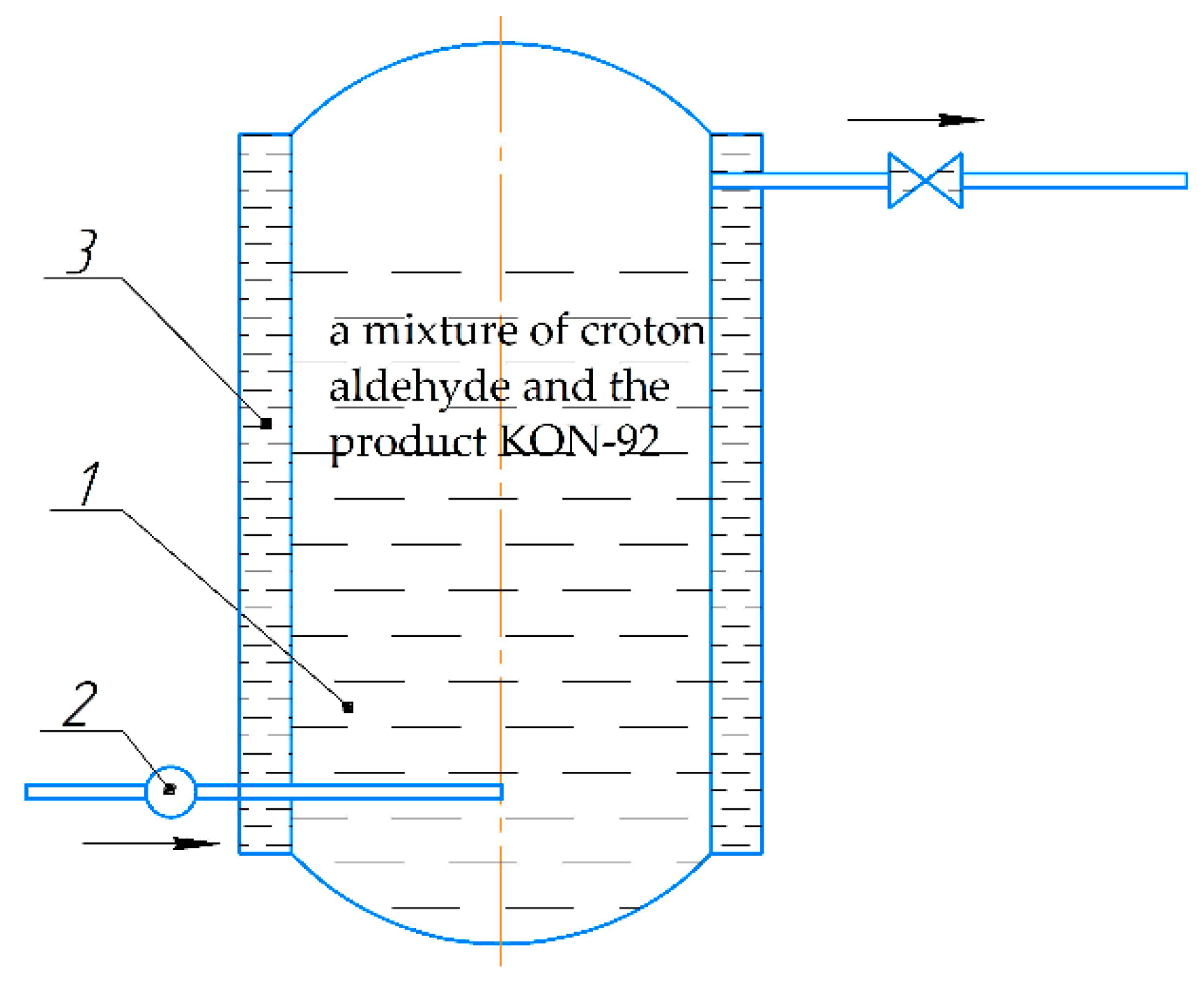

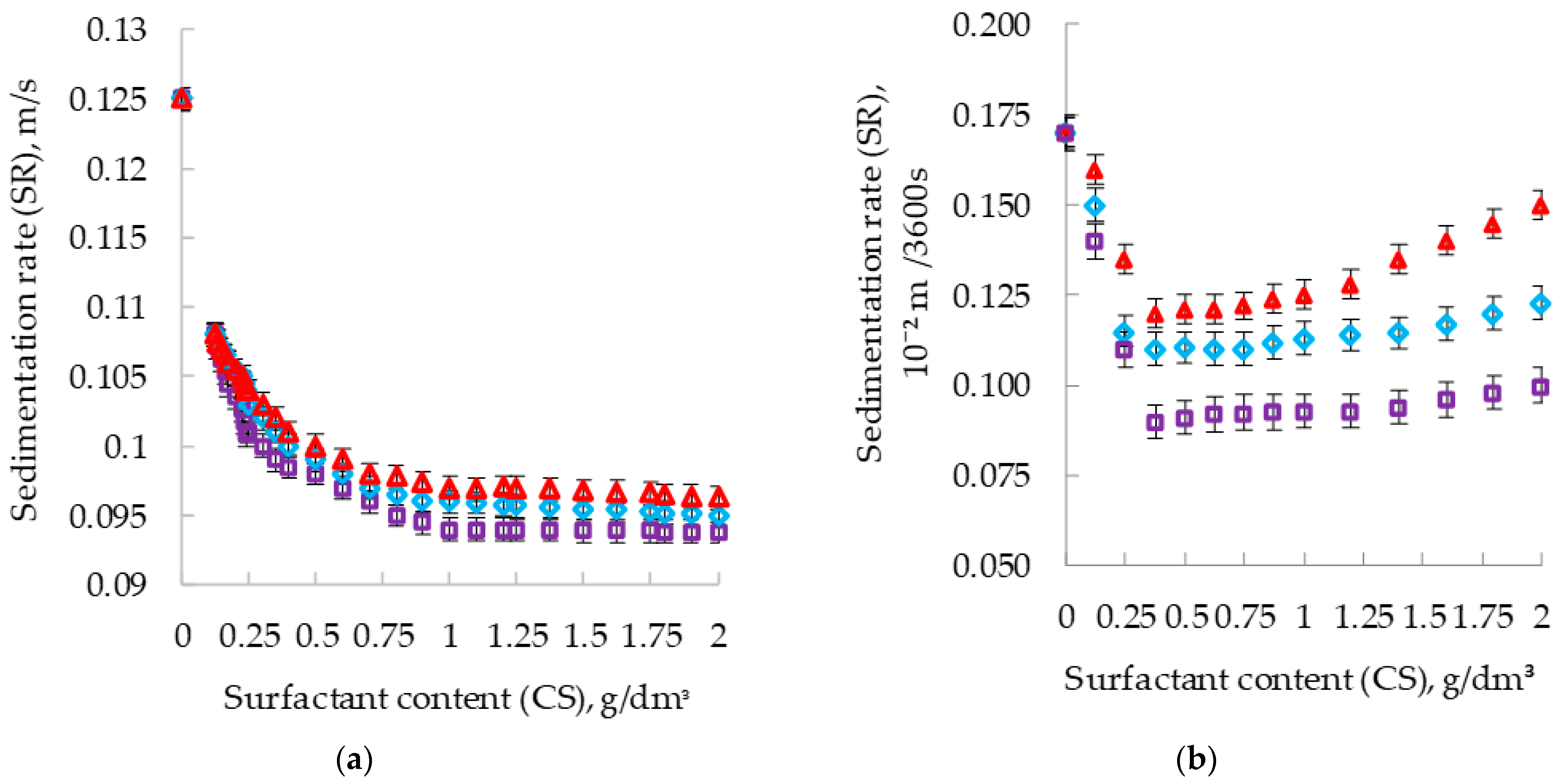

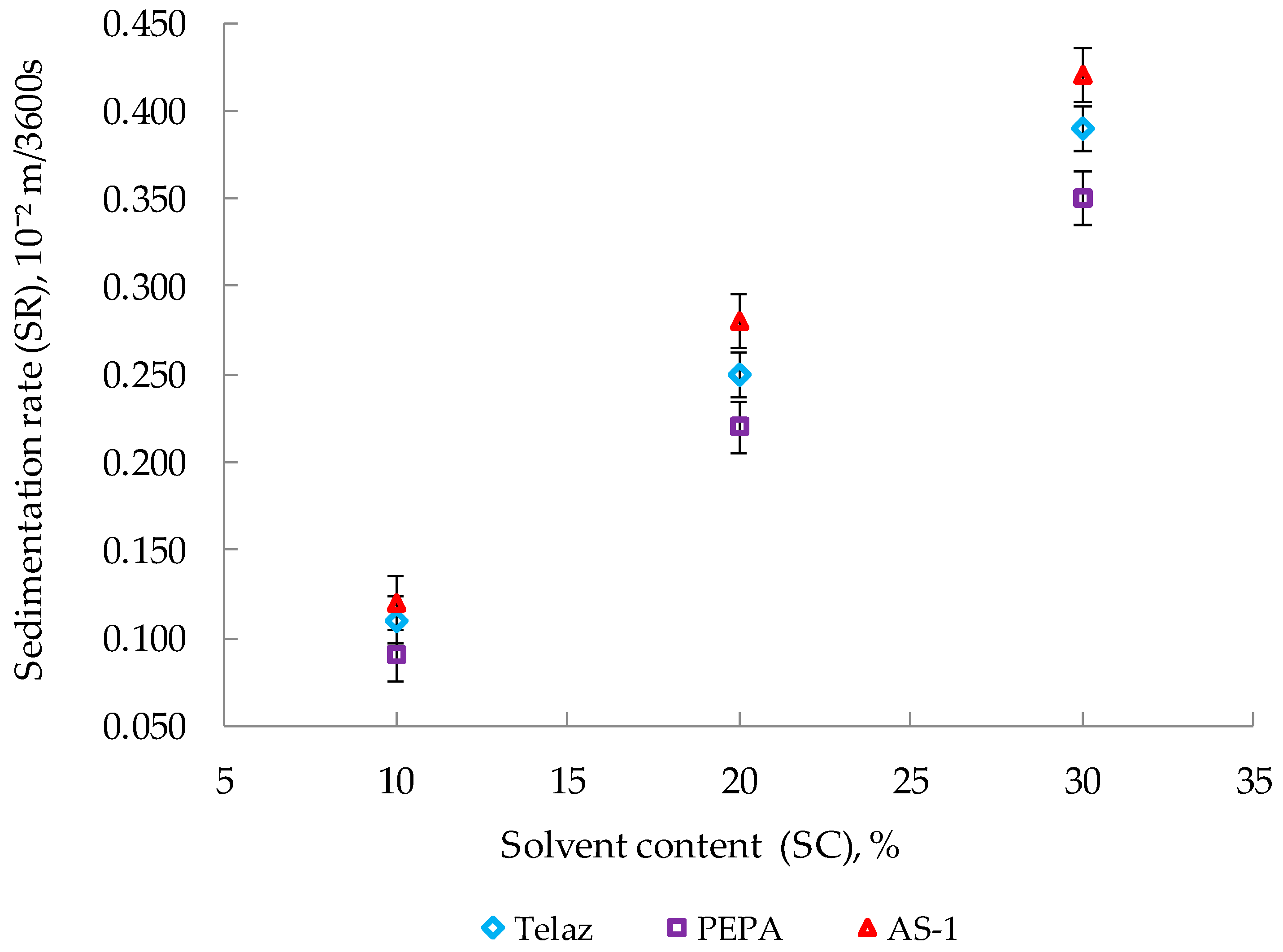
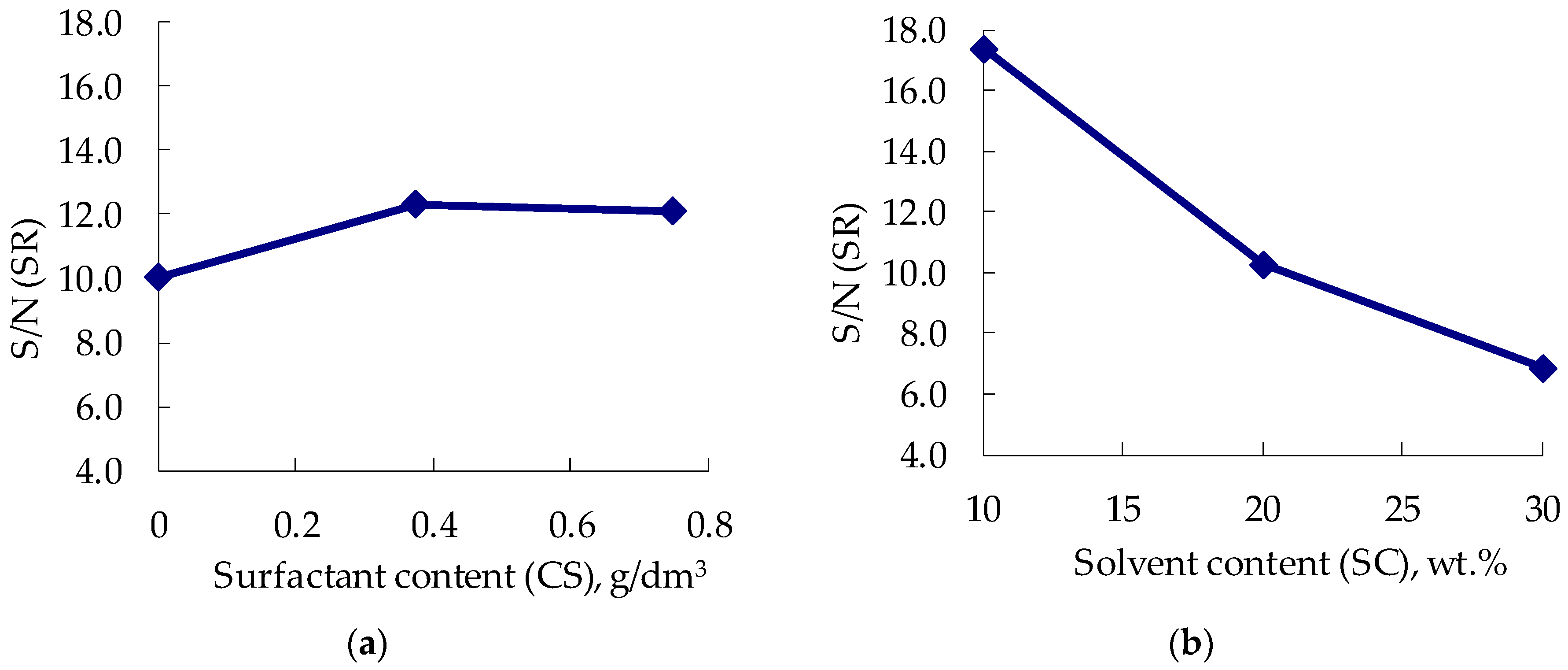
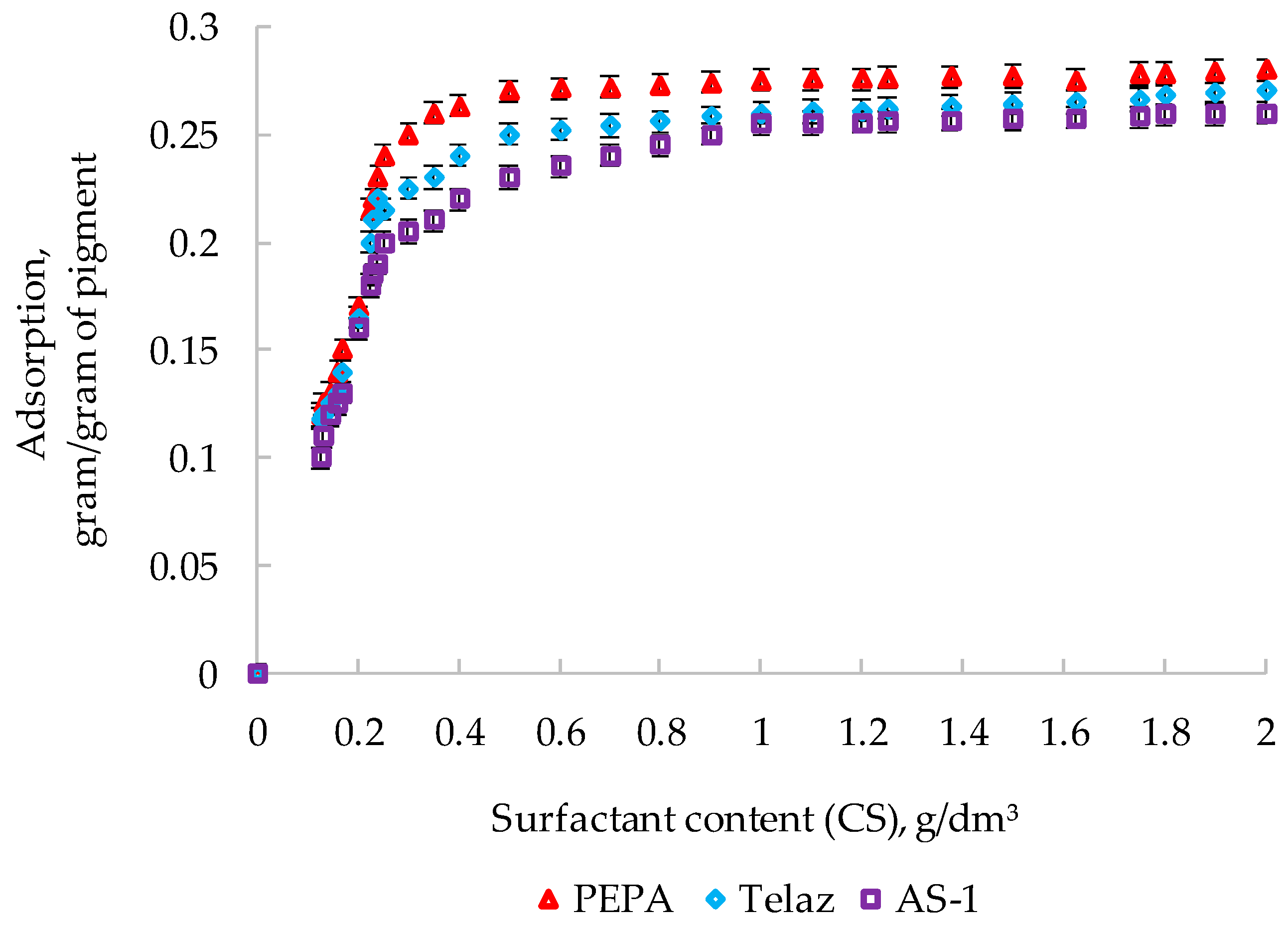
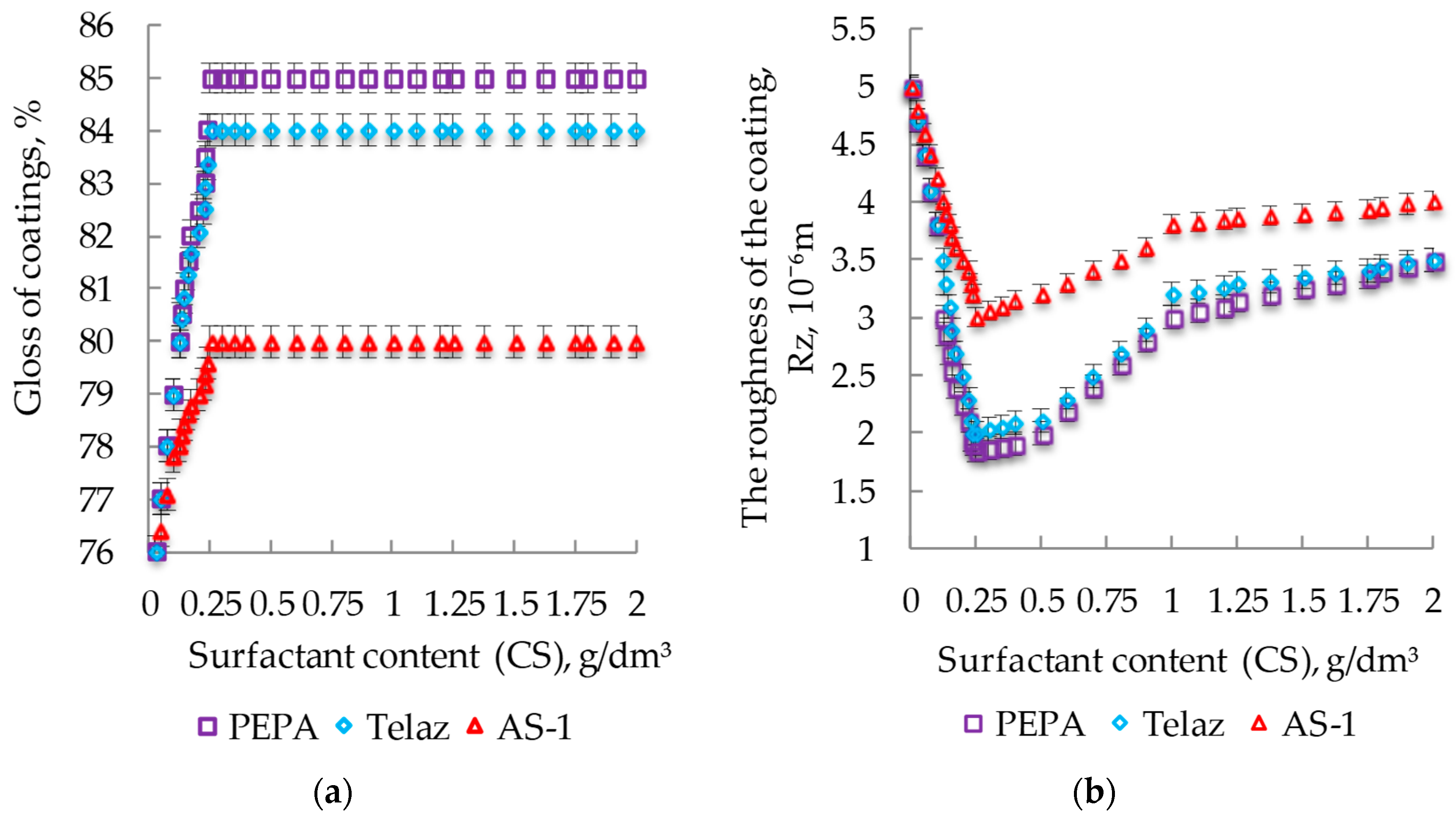
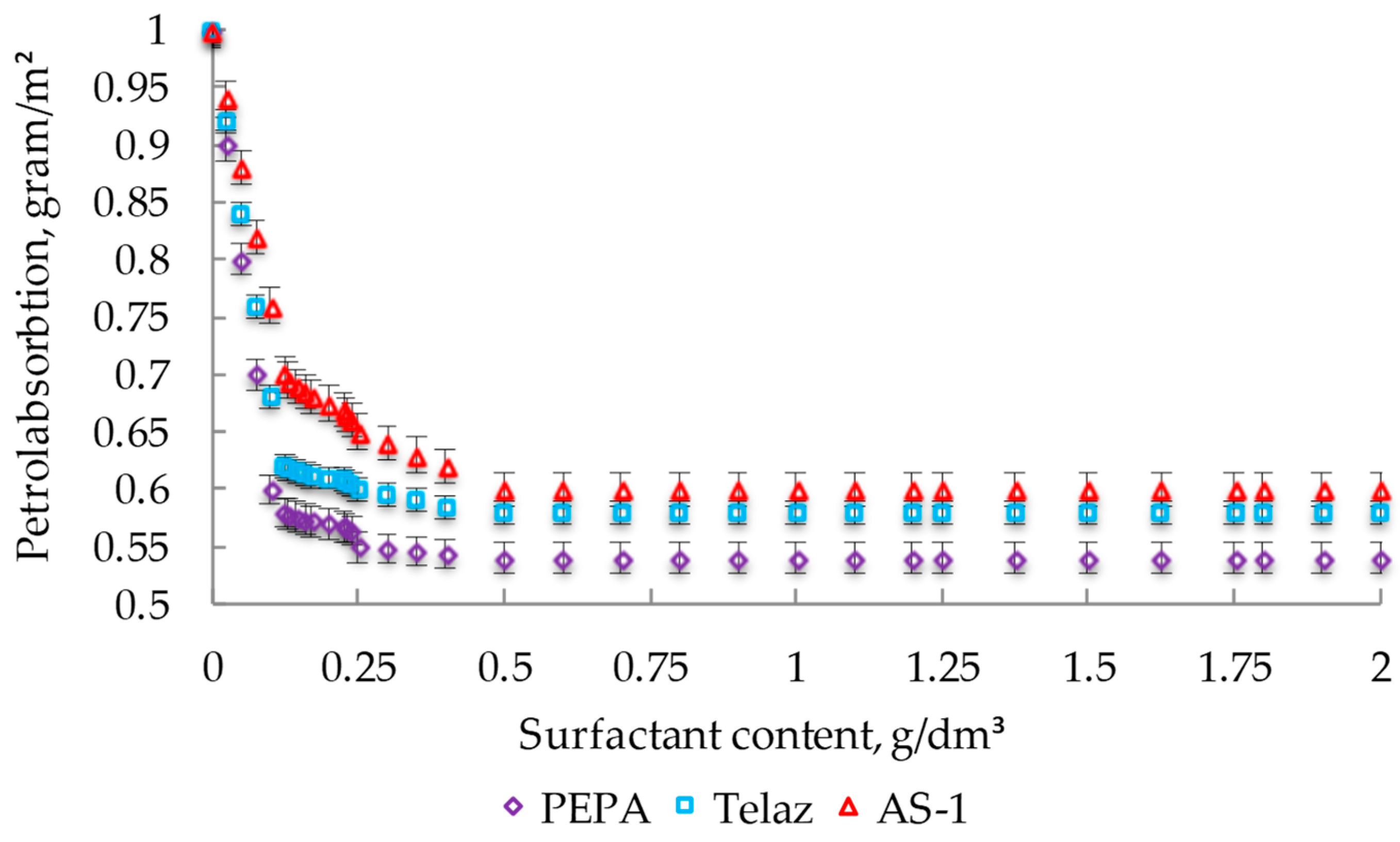
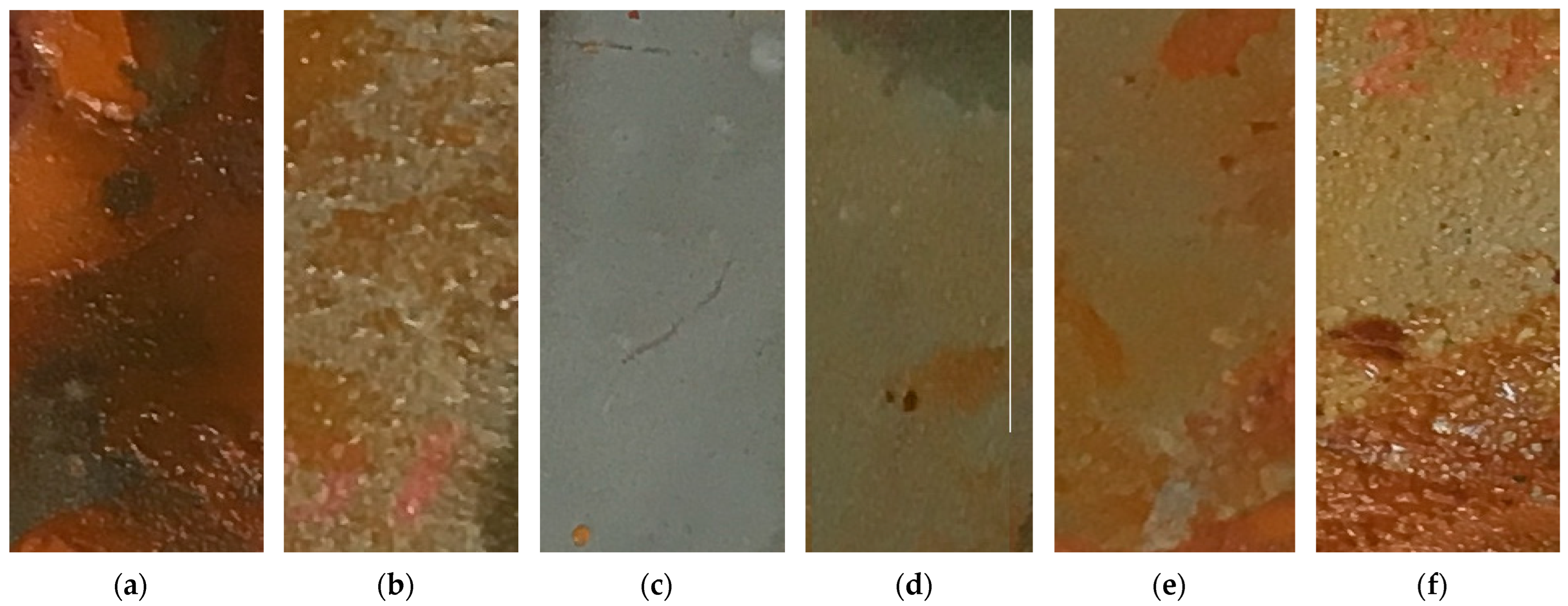


| Factors | Level 1 | Level 2 | Level 3 |
|---|---|---|---|
| CS (g/dm3) | 0 | 0.375 | 0.75 |
| SC (wt.%) | 10 | 20 | 30 |
| Trial | CS (g/dm3) | SC (wt.%) | S/N Ratio for SR, (dB) | SR, 10−2 m/3600 s (10−2 m/h) |
|---|---|---|---|---|
| 1 | 0 | 10 | 15.391 | 0.170 |
| 2 | 0 | 20 | 9.119 | 0.350 |
| 3 | 0 | 30 | 5.680 | 0.520 |
| 4 | 0.375 | 10 | 18.416 | 0.120 |
| 5 | 0.375 | 20 | 11.057 | 0.280 |
| 6 | 0.375 | 30 | 7.535 | 0.420 |
| 7 | 0.75 | 10 | 18.273 | 0.122 |
| 8 | 0.75 | 20 | 10.663 | 0.293 |
| 9 | 0.75 | 30 | 7.371 | 0.428 |
| Level | S/N Ratio | |
|---|---|---|
| CS (g/dm3) | SC (wt.%) | |
| 1 | 10.063 | 17.360 |
| 2 | 12.336 | 10.279 |
| 3 | 12.102 | 6.862 |
| Delta | 2.273 | 10.498 |
| Rank | 2 | 1 |
| Factor | Degrees of Freedom | Sum of Squares | Contribution of Factor, (%) |
|---|---|---|---|
| CS (g/dm3) | 2 | 9.38 | 5.17 |
| SC (wt.%) | 2 | 172.02 | 94.83 |
| Total | 4 | 181.40 | 100 |
| № | Surfactant | a | b | c | d | e | SRM |
|---|---|---|---|---|---|---|---|
| 1 | PEPA | 0.5084 | −0.5284 | 0.3467 | 0.0151 | −0.0348 | 0.2677 |
| 2 | Telaz | 0.4030 | −0.4089 | 0.3467 | 0.0158 | −0.0272 | 0.2878 |
| 3 | AS-1 | 0.2880 | −0.3036 | 0.3467 | 0.0159 | −0.0183 | 0.3003 |
| Parameter | PEPA | Telaz | AS-1 |
|---|---|---|---|
| Eact., kJ/mol | 18 | 15 | 16 |
Publisher’s Note: MDPI stays neutral with regard to jurisdictional claims in published maps and institutional affiliations. |
© 2022 by the authors. Licensee MDPI, Basel, Switzerland. This article is an open access article distributed under the terms and conditions of the Creative Commons Attribution (CC BY) license (https://creativecommons.org/licenses/by/4.0/).
Share and Cite
Tyukanko, V.; Demyanenko, A.; Dyuryagina, A.; Ostrovnoy, K.; Aubakirova, G. Optimizing the Composition of Silicone Enamel to Ensure Maximum Aggregative Stability of Its Suspensions Using Surfactant Obtained from Oil Refining Waste. Polymers 2022, 14, 3819. https://doi.org/10.3390/polym14183819
Tyukanko V, Demyanenko A, Dyuryagina A, Ostrovnoy K, Aubakirova G. Optimizing the Composition of Silicone Enamel to Ensure Maximum Aggregative Stability of Its Suspensions Using Surfactant Obtained from Oil Refining Waste. Polymers. 2022; 14(18):3819. https://doi.org/10.3390/polym14183819
Chicago/Turabian StyleTyukanko, Vitaliy, Alexandr Demyanenko, Antonina Dyuryagina, Kirill Ostrovnoy, and Gulsim Aubakirova. 2022. "Optimizing the Composition of Silicone Enamel to Ensure Maximum Aggregative Stability of Its Suspensions Using Surfactant Obtained from Oil Refining Waste" Polymers 14, no. 18: 3819. https://doi.org/10.3390/polym14183819
APA StyleTyukanko, V., Demyanenko, A., Dyuryagina, A., Ostrovnoy, K., & Aubakirova, G. (2022). Optimizing the Composition of Silicone Enamel to Ensure Maximum Aggregative Stability of Its Suspensions Using Surfactant Obtained from Oil Refining Waste. Polymers, 14(18), 3819. https://doi.org/10.3390/polym14183819





